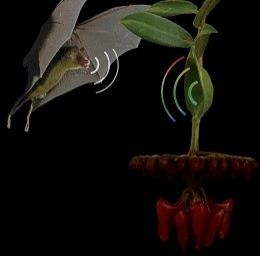Vine's Dish-Shaped Leaves Send Sound Signals to Bats

Plants employ various techniques to improve pollination. Bright colors and alluring aromas are but old tricks. A new plant has been found to have a have a built-in-the-home echolocation system which they use to gain higher rate of pollination.
In a study that throws light into how plants have been developing echo-acoustic signals, scientists have found that Marcgravia evenia, a unique rainforest vine in Cuba, receives higher amount of pollination by attracting bats by evolving leaves that serve as an echo beacon.
The scientists found that the plant attracts bats by using its dish-shaped leaves to bounce back echoes which bats pick up easily and frequent the plants at higher rate, helping the pollination process.
“They have a very special kind of echo ... This echo is very loud and has a constant signature from different angles,” said Ralph Simon, a biologist at the University of Ulm in Germany, who is the lead author of a study published in journal Science.
The scientists simulated the effect of echolocation system developed by the plant in the lab. Nectar-feeding bats, Glossophaga soricina, were trained to look for a feeder which was attached to a dish-shaped leaf, an ordinary leaf or no leaf.
They found that the bats found the feeder quickly when it placed in a dish-shaped leaf. Sounds that bounced back to the bats resulted in multiple visits to pollinate the same plants, researchers found. In addition, search times were reduced by almost half, from 23 seconds down to 12 seconds, according to the study.
Dr Marc Holderied of Bristol's School of Biological Sciences, who is the co-author of the paper, said: "This echo beacon has benefits for the both the plant and the bats. On one hand, it increases the foraging efficiency of nectar-feeding bats, which is of particular importance as they have to pay hundreds of visits to flowers each night to fulfill their energy needs. On the other hand, the M. evenia vine occurs in such low abundance that it requires highly mobile pollinators."
The new study shows plants have been evolving new techniques in augmenting pollination. It has been widely see that plants rely on bright colors to attract bees and birds for pollination.
The researchers said the Cuban rainforest vine developed a distinctively shaped concave leaf next to its flowers, which is reminiscent of a dish reflector. By analyzing the leaf's acoustic reflection properties, they found that it acts as an ideal echo beacon, sending back strong, multidirectional echoes with an easily recognizable, and unvarying acoustic signature – perfect for making the flower obvious to echolocating bats.
© Copyright IBTimes 2024. All rights reserved.





















